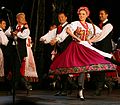National costumes of Poland (Polish : stroje ludowe) vary by region. They are typically not worn in daily life but at folk festivals, folk weddings, religious holidays, harvest festivals and other special occasions. [1] The costumes may reflect region and sometimes social or marital status. [1]
Contents
- Lesser Poland / Małopolska
- Gorals / Górale
- Subcarpathian region / Podkarpacie
- Lublin region
- Silesia / Śląsk
- Pomerania / Pomorze, Kujawy, Warmia
- Masovia and central Poland
- Podlaskie / Podlasie
- Greater Poland / Wielkopolska
- Upper class
- Burghers
- See also
- References
- External links
Poland's inhabitants live in the following historic regions of the country: Greater Poland, Lesser Poland, Mazovia, Pomerania, Warmia, Masuria, Podlachia, Kuyavia and Silesia.





























































